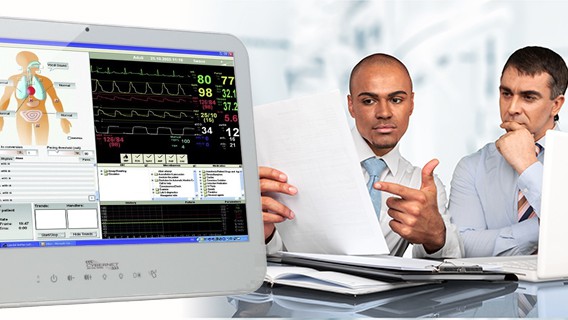Healthcare is always looking for ways to increase productivity. One example is using fewer steps to bring a patient out of a coma. Another would be making sure medical staff on the swing shift are not left scrambling for working equipment by verifying all battery-powered medical computers and other devices are fully charged and ready to go.
Technology can aid in productivity. Take the process of record-keeping through medical transcription. It went through huge changes thanks to the personal computer, the Internet, speech recognition software, and EMR.
Medical Transcription: A Brief History
Article Guide
Doctors have been taking notes on patients for a long time. In fact, the earliest ones date back to 1600 BC and were discovered in Egypt. They were written on papyrus.
The modern system of medical transcription started in the 1960s. Medical transcription is simply the process of turning a doctor’s notes into a formal written record. This was started by the newly established hospitals and other medical facilities at the time and is a vital part of healthcare.
Back then, doctors would say, or dictate, their observations to the office secretaries or stenographers, who would write them in shorthand. They would later transcribe their writings for the patient’s files.
The process was simple but time-consuming. The secretaries or stenographers would have to be present when the doctor made their dictation, which affected their other duties. The introduction of tape recorders really paved the way for the modern medical transcriptionists. This is especially true for the portable ones. The physicians dictated their thoughts into such devices, then simply handed them over to the transcriptionists. They in turn would listen to the recordings and transcribe them into files usually with a typewriter.
Physicians, freed from the tedious and time-consuming task of record-keeping, could see more patients or do life-saving research. This process stayed the same until the arrival of speech recognition software.
Transcribing 24/7: PC, Internet
Say bye-bye to paper
The arrival of the personal computer in the Eighties was game-changing. Simply, the PC largely eliminated paper in transcribing. Transcriptionists no longer wasted reams to correct a particular word or to insert a paragraph from the typewritten page. Carbon paper for copies, and bottles of whiteout and correcting ribbon for corrections, became obsolete.
Transcriptionists would first type the doctor’s dictations in the PC’s word-processing software. They would review their work on a medical panel PC for any mistakes and correct them. Afterwards, the patient’s files were stored electronically or printed out.
Productivity went up as the PC sped up transcription while containing fewer errors.
Internet makes transcription available anywhere, anytime
The Internet affected productivity in two distinct ways. First, clinicians no longer needed to hand over their dictations to the transcriptionist. They could simply upload them online. The transcriptionists would then download it anywhere there was an internet connection, transcribe it, and upload it back.
This ability meant transcriptionists no longer needed to be in the clinic. Medical groups converted the now available office space into more patient exam rooms or on-site network servers.
The ability to access clinicians’ recordings anywhere lead to the second change in productivity. Since transcribing could be done anywhere, medical offices didn’t have to rely on local transcriptionists and their work hours. The clinician could hire transcriptionists on the other side of the world like India. These transcriptionists would transcribe the file during their open hours, then upload the completed work before the clinician’s office even opened the following day. Sometimes the files were available even earlier.
Speed was not the only advantage. Many of these foreign services were usually less expensive due to the differences in labor costs between countries.
Game-changes: Speech Recognition, EMR
Clinicians assume transcriptionist duties with speech recognition
Normally, it takes around four hours for an experienced transcriptionist to transcribe one hour’s worth of clinician’s dictations into a well-edited, legible document.
The arrival of speech recognition turned medical dictation on its head. Speech recognition, also known as voice-to-text, is software loaded on a desktop PC or streamed from the cloud. Clinicians now dictated their observations directly into the software which transcribes them word-for-word into text.
Medical office staff no longer had to wait on any medical transcriptionists. Patient files could be filed and stored once the clinician had edited them for accuracy. This last step is important. The software could mis-hear the clinician and type, as an example, “80 units of insulin” instead of “8 units of insulin” which would put a patient into a coma. Many studies on speech recognition software used in medicine show a consistent error rate of around 7 percent, with nearly 6 percent of those errors to be “clinically significant.”
The error rate from a medical transcriptionist is around 0.4 percent. This drops to 0.3 percent after being reviewed by the clinician.
The impact of speech recognition software on productivity depends on whom one speaks with. On the one hand, there is no medical transcriptionist in the process of record-keeping. This supposedly makes it faster and less costly for the medical group. On the other hand, clinicians must allocate their limited time from patient care to (virtual) paper pushing. The trend in healthcare right now is increased use of the software.
EMR structures clinicians record-keeping
Electronic medical records (EMR), also known as electronic health records (EHR), were introduced in 2015. The hope was that such systems would increase productivity in healthcare by simplifying patient records as well as make them easier to access for patients and medical groups alike.
EMRs use a “structured data” design. Any patient record is documented through numerous checkboxes, cookie-cutter templates, drop-down lists, macros, and point-and-click fields. Clinicians have to make sure their transcriptions are also set up appropriately in the EMR.
Again, the effect of EMR and productivity depends on whom one talks to. The trend, just like with speech recognition, is the increased rollout of EMRs throughout healthcare.
Closing Thoughts
Like any other industry, healthcare is always looking for ways to increase its productivity. Technology, from medical-grade PCs to software, can dramatically change the productivity of related health fields like medical transcription. Contact an expert at Cybernet if you’re looking to learn more how such technologies can impact your medical record-keeping. Also follow Cybernet on Facebook, Twitter, and Linkedin to stay up to date on this and other relevant topics.
How Medical Computers Are Revolutionizing the Healthcare Industry
October 4, 2015
Medical computers manage patients’ information and allow functions like writing & tracking prescriptions, managing patient billing and tracking all aspects of a patient's medical care. Medical computers are…
0 Comments6 Minutes
What is the Future of Medical Transcription?
March 10, 2022
Medical workers are highly-skilled, educated professionals in the highest demand they’ve ever been, and the hospital of the future is the one that respects and preserves their precious time. To create the hospital of…
0 Comments10 Minutes
You Can't
Learn from a Pop-up
But we can deliver knowledge to your inbox!
We dive deep in the industry looking for new trends, technology, news, and updates. We're happy to share them with you.
Knowledge, News, and Industry Updates Right in Your Inbox




